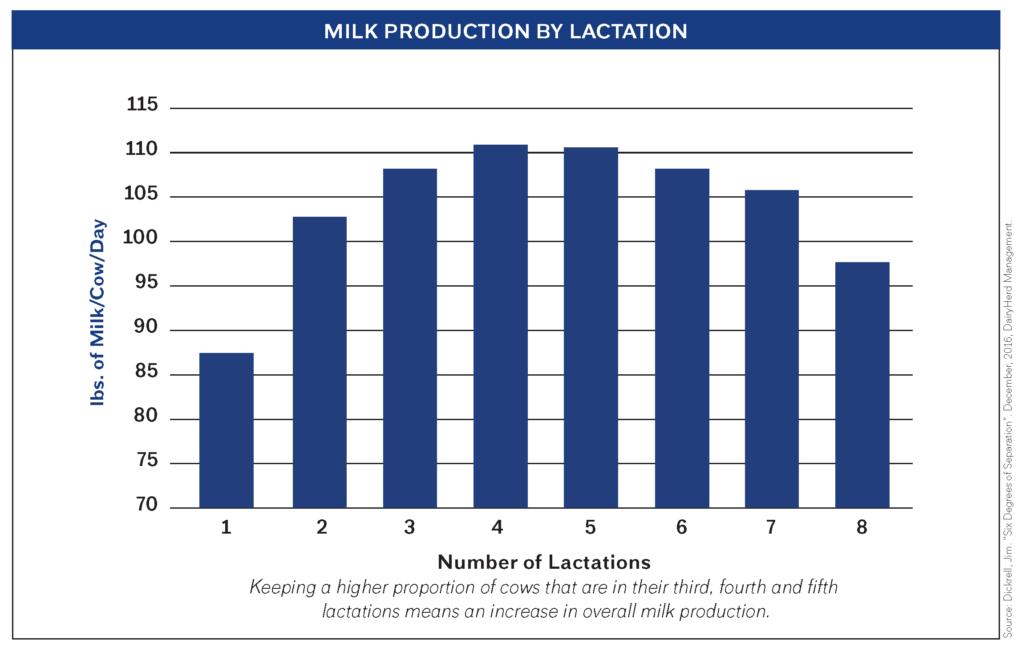Improving Longevity In Your Dairy Herd
Click here to view as a pdf: Improving Longevity In Your Dairy Herd
By Teresa Marker, B.S.
Healthy cows tend to stay in the herd longer. Currently, in the United States, the average productive lifetime for a dairy cow is 2.5 lactations. A cow does not mature until five years of age. Many cows are involuntarily lost during the first two months of lactation. The majority of these animals are removed from the herd due to poor transitions, lameness, mastitis and reproductive issues. There are several ways to improve longevity of a dairy herd which will ultimately lead to improved milk production and profitability for the dairy farm. Strategies to improve longevity on the dairy farm include: cull based on parity, bring in less heifers every year, improve the transition into lactation, focus on colostrum management, feed quality forage, and provide proper nutrition for all groups.
Evaluate Culling Based On Parity/Bring In Less Heifers Every Year
Approximately 30-45% of cows in an average herd are replaced each year. Of those annual culls, 70-80% are avoidable. By improving the overall health of the herd, farmers can start to evaluate and cull cows based on parity. The chart below shows that cows have the most milk production potential during their 3rd, 4th and 5th lactations. Farmers may focus on bringing heifers into the herd for their genetic potential in milk production. The current industry average includes bringing in 35% of the herd as heifers. This practice helps bring in better genetics but it also decreases overall herd age and milk production potential. The sad truth is most cows are only staying in the herd for 2.5 lactations so they are not even getting close to showing us their true milking potential. Keeping older cows that are in their 3rd, 4th and 5th lactation can improve the average age of the herd and present a chance for improved milk production due to their increased milk production potential. Reducing the heifer percentage in the milk herd down to 20% can help to increase herd age and increase milk production. There are several ways to keep heifer percentage down to 20%. One way is to raise less heifers each year. This would also reduce heifer feed cost, labor and space requirements. Another option would be to freshen in all of the heifers and sell post-fresh heifers. This option would allow a producer to keep the calves with the most genetic potential.
Improve Transition Into Lactation
Involuntary culling in the first 60 days after freshening is damaging to the pocketbook. Research shows that this involuntary culling costs anywhere from $500-$1,500 per cow per year not including lost milk production or extra labor cost. The first step in improving the transition into lactation involves evaluating the prevalence of fresh cow diseases such as milk fever, ketosis, metritis, and mastitis. Establishing a baseline for where the herd is currently at will help in making a game plan for future changes. Work with a nutritionist and veterinarian to create a strategy that will set the cows up for success during their transition. Areas to look at include: dry cow diet, pen changes during the dry period, bunk management pre and post-fresh, fresh cow nutrition, post-fresh management/testing for ketosis, mycotoxins, and heat stress abatement. An improved transition into lactation will help keep cows in the herd longer, increase milk production and improve dairy farm profitability.
Colostrum Management
Proper colostrum management can have major long term benefits. Research shows that calves given 4 quarts of high quality colostrum versus those given only 2 quarts of colostrum have a 0.5 lb. higher average daily gain, breed 0.5 month sooner, produce over 2,200 lbs. more milk in the first and second lactations and are 12% more likely to survive past the 2nd lactation. Crystal Creek® recommends feeding 4 quarts of colostrum containing 200 grams of IgG within 4 hours after birth. If the calf experienced a difficult delivery, increase the grams of IgG given to 250 grams. Colostrum can be measured using a digital refractometer. The readout number corresponds to the grams of IgG (immunoglobulins) per quart of colostrum. See Crystal Creek’s chart “Colostrum Reading” on page 35 of the 2018 Crystal Creek® Product Catalog.
Feed Quality Forage
A sound nutrition program starts with good quality forage. Harvesting forage at the right time is ideal but weather can have a major affect on harvesting plans. Using a quality inoculant, such as Inoc-U-Lock™ will help to control the fermentation process enabling the forages to ferment properly. Using Inoc-U-Lock™ can help reduce dry matter loss, nutrient loss and decrease the risk for mycotoxin growth in storage. Better quality feed will lead to improved milk production, healthier cows and ultimately more profit.
Provide Proper Nutrition
The Crystal Creek® Dairy Nutrition Model (CCDNM) focuses on raising healthy, durable animals to increase herd longevity. Our nutritionists encourage utilizing homegrown forages to minimize purchased products. The focus is not only on proper lactating cow nutrition, but also balancing rations for heifers and dry cows, setting the stage for a good transition. Many herds on the CCDNM have seen improvements in breeding, foot health, transition cow health, somatic cell counts and improved component numbers.
There are a number of ways to improve longevity in a dairy herd and the steps outlined above are good starting points. Evaluating your current management practices to retain animals that consistently perform at a higher efficiency will have a positive economic impact on your herd. Ultimately, increasing the age of the cows in the herd will lead to improved milk production and greater producer profitability. Contact the staff at Crystal Creek® for more information on ways we can help with improving your herd longevity.

